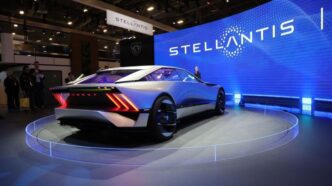Stellantis has confirmed it’s winding down its in-car software partnership with Amazon, three years after announcing plans to launch a connected vehicle platform by 2024. Initially seen as a cornerstone of Stellantis’ ambitious software roadmap — aimed at generating $22.5 billion annually — the joint effort with Amazon never materialized.
The decision to part ways was first reported by Reuters, which noted that many Amazon staff assigned to the project have either been reassigned or exited the company entirely. Stellantis later confirmed the report to TechCrunch, saying it is now pivoting to a more standardized Android-based operating system for its vehicles.
From SmartCockpit to Android: A Shift in Strategy
Originally, Amazon was enlisted to help build the STLA SmartCockpit — one of three key layers in Stellantis’ broader software plan. At the core was STLA Brain, an advanced vehicle electrical and software architecture. The SmartCockpit was designed to sit atop this foundation, offering personalized navigation, voice commands, e-commerce features, and an in-vehicle marketplace.
Amazon’s role was to power the intelligence behind this cockpit, leveraging its cloud infrastructure and AI capabilities to tailor the experience to individual users. But with the project now shelved, Stellantis says it is still committed to developing its smart cockpit — just without Amazon’s direct involvement.
Instead, Stellantis is turning to Android, joining a growing list of automakers that rely on Google’s automotive software. The shift indicates a preference for scalability, developer familiarity, and integration with existing Android-based infotainment ecosystems.
Despite the pivot, Stellantis said its relationship with Amazon isn’t over. The automaker will continue to use Amazon Web Services (AWS) as its preferred cloud provider for vehicle platforms, and Alexa voice assistant will remain integrated into its vehicles.
Software Ambitions Still Alive but Routes Are Changing
In December 2021, Stellantis announced its plan to have 34 million connected cars on the road by 2030. Software and subscription services were expected to be a major revenue stream — from navigation tools and infotainment, to voice assistants, payment systems, and predictive maintenance alerts.
To achieve that vision, Stellantis struck deals not only with Amazon, but also with BMW, Waymo, and Foxconn. While the AutoDrive system, developed with BMW, and STLA Brain remain in play, the sunset of the Amazon deal highlights the complexity of transforming traditional auto manufacturing into a tech-centric model.
For now, Stellantis is keeping its SmartCockpit vision intact — just with Android powering the experience. As the automaker chases its long-term software revenue goals, it appears to be favoring more flexible, proven platforms over ambitious bespoke solutions that have struggled to scale.













